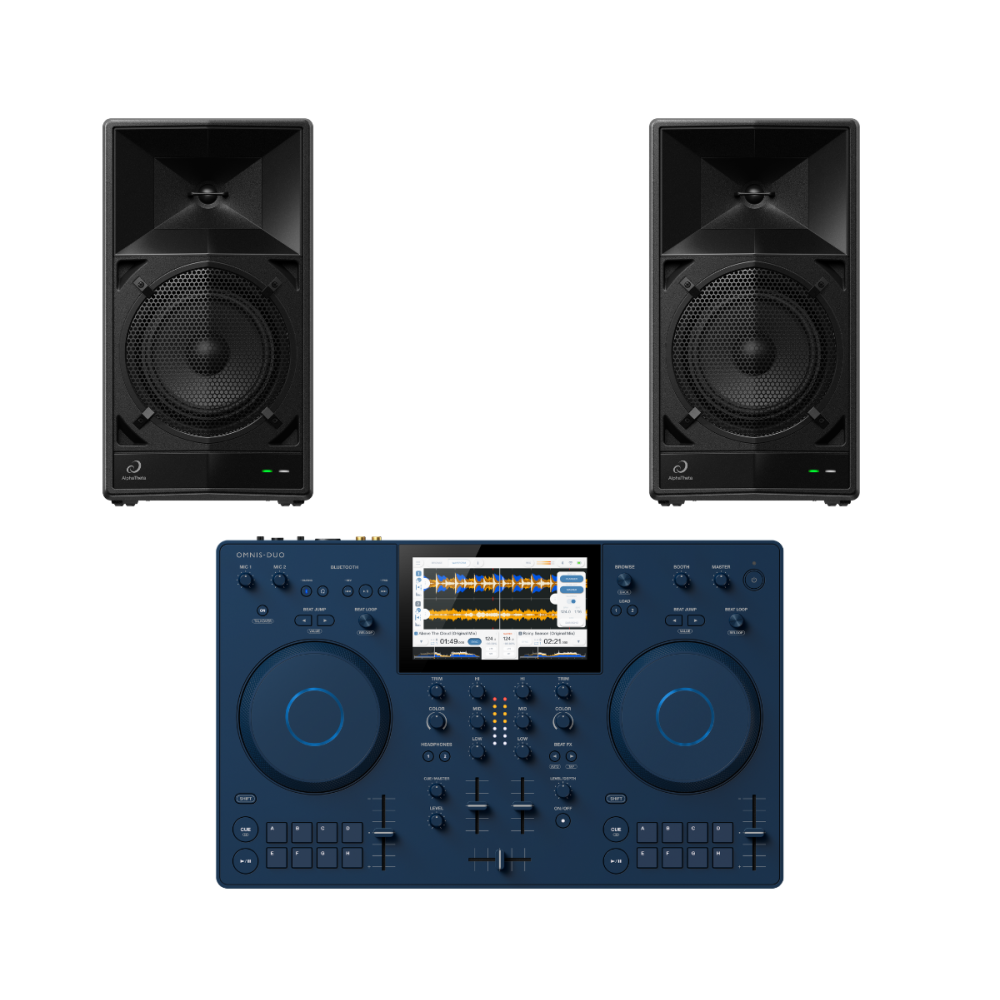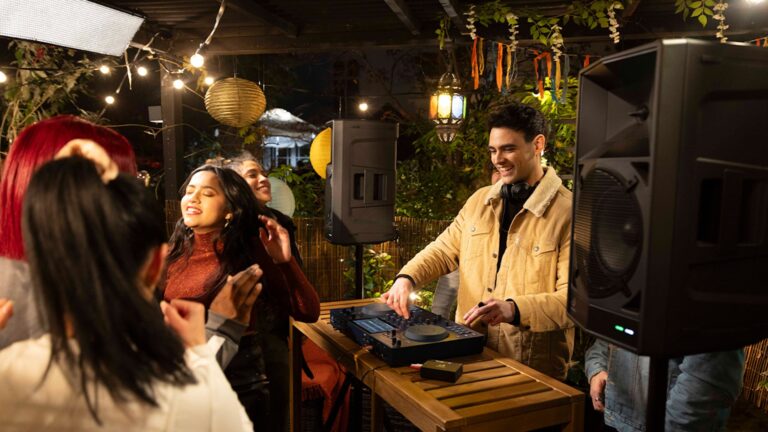Review: The newly launched AlphaTheta products: OMNIS-DUO, a two-channel, portable, all-in-one DJ system, and WAVE-EIGHT, powered speaker on-the-go.
In the late-1980s, Toyota wanted to capture a different segment of the automotive market. The Japanese manufacturer had already established a name for itself by introducing affordable, well-built, and reliable cars year after year, but it wanted to move upmarket. Executives felt that the best way to do this was to create an entirely new brand specifically for the new, luxury cars they created. So, at the 1989 Detroit Motor Show, the world got a chance to meet that new brand: Lexus.
Now, as the company that we’ve all long known as Pioneer DJ rolls out new, forward-thinking products from its AlphaTheta brand, I can’t help but see a little homology between this and the Lexus saga. With that in mind, I had a chance to play with the first two members of the AlphaTheta brand family: the OMNIS-DUO (a battery-powered all-in-one DJ system) and the WAVE-EIGHT (a battery-powered portable speaker). We’ll dive into each individually.
OMNIS-DUO
The OMNIS-DUO is a two-channel, portable, all-in-one DJ system with a built-in battery and a large central touchscreen. The biggest change from the industry norms might be its new design language. It’s a dramatic departure from what many of us have come to expect from Pioneer DJ-related products.
My unit came in a deep, blue tone with brightly contrasting white labels for all the buttons and switches. The company calls the color “indigo blue” and say the tone is inspired by denim jeans. It feels very minimalist – different from Pioneer DJ’s typical maximalist design language. However, this isn’t the first minimalist and avant-garde design from Pioneer DJ or AlphaTheta. Last year, Pioneer DJ’s OPUS-QUAD all-in-one unit introduced a striking black-and-gold color scheme reminiscent of some high-end audiophile gear.
The centerpiece of the OMNIS-DUO has to be the large touchscreen at the top center. It is extremely responsive and easy to use. It controls virtually all aspects related to browsing, waveforms, and settings for the device. There are two color profiles – one called day mode and the other called a night mode.
Below the touch screen is the mixer section. There are three-band EQ knobs for each channel along with dedicated sound-color and trim knobs. The sound-color knobs default to a combination high/low-pass filter, but other effects can be selected on the screen.
Both the channel faders and the crossfader have a different morphology than what I’m accustomed to – they’re quite narrow compared to faders on other DJ mixers, and I had to adjust when attempting scratch routines. The narrow faders are by no means a deal-breaker for me, but I personally would’ve liked wider faders. Similarly, all the knobs feel slightly different from those of other DJ products. I’m sure I will be able to adjust my muscle memory in no time, but this is worth bringing up in a review.
To the right of the channel faders are the physical controls for the effects. The specific effect is selected by the screen, but there are physical controls for turning on/off the selected effect, adjusting the effect level/depth, and selecting the beat value for the effects.
On the back, there are the usual inputs/outputs. At the far left, there is a USB-C connector to charge and power the unit. Every OMNIS-DUO unit ships with its own power cable, but you can use any USB-C cable capable of supplying at least 45 watts of power. (Most laptop chargers should be able to handle this with no issue).
The built-in battery is rated for approximately five hours of run-time after a three-hour charge from empty. There is an “eco” mode that can be activated to conserve battery life; when this mode is active, some functions are temporarily disabled, and the screen becomes dimmer. There are three main ways to connect the OMNIS-DUO to a music library. One, there are ports to connect a USB flash drive or an SD card with individual music files. You do not have to have any music pre-analyzed in the rekordbox software – the system can analyze music on-the-fly, but it is more seamless to pre-analyze tracks beforehand.
Second, the OMNIS-DUO can connect to a WiFi network, allowing a user to send track files from rekordbox wirelessly via Export mode or access songs on a cloud-based library. Finally, there’s a second USB-C port that allows users to connect the unit to a laptop running DJ software. At the time of writing this review, rekordbox Performance mode and Serato DJ Lite/Pro are supported.
I did try the rekordbox Performance integration, and the OMNIS-DUO felt just like a controller with a built-in screen. The screen continued showing waveforms and my library, which allowed me to take my eyes away from my laptop.
One killer feature is Bluetooth integration. Now, other DJ all-in-one units have incorporated wireless playback via Bluetooth, but the OMNIS-DUO takes things to the next level. You can directly assign the Bluetooth input to a mixer channel or go one step further with the Bluetooth Playback mode. In this mode, audio signal via Bluetooth sent to the OMNIS-DUO is analyzed in real-time and made available as a playable track, meaning it is possible to scratch and drop cues on-the-fly using any audio sent via Bluetooth. While Bluetooth Playback is an insanely cool feature to play with, it remains to be seen how much use it actually gets in live environments and how DJs are able to integrate it into their workflows.
DJs can connect the OMNIS-DUO to speakers via XLR or RCA cables or wirelessly through a Bluetooth output. There are two mic inputs – one on TRS and one on XLR connectors. Level knobs for the mics are on the top left, and there’s a single talk-over button for both mic inputs. On the front, there are two headphone jacks – one for 1/8-inch and one for ¼-inch headphone cables.
So the million-dollar (or $1,499) question is: Who might the OMNIS-DUO be aimed at? Party or bedroom DJs who want a portable all-in-one solution with battery power would feel right at home here, and they can build their rekordbox library in such a way that transitioning to CDJs or other club-standard gear will be no issue. I could also see mobile DJs or event DJs loving the battery power, portability, and design of the OMNIS-DUO for their gigs.
If portability or battery power is not a major factor, I would probably recommend the cheaper XDJ-RR, which offers all-in-one functionality and a large screen. Step up to the more-expensive XDJ-RX3 or XDJ-XZ from Pioneer DJ for even more features. Similarly, Numark’s Mixstream Pro Go offers portable, battery-powered all-in-one playback and also includes a built-in speaker – it is around 60-percent the price of the new OMNIS-DUO. And, for DJs who want the most-portable, all-in-one system, Denon DJ’s Prime Go is even smaller. Both the Prime Go and Mixstream Pro Go run on Engine OS, so DJs who want to use the rekordbox ecosystem should stick with the OMNIS-DUO or XDJ-RR.
WAVE-EIGHT
Alongside the OMNIS-DUO came the WAVE-EIGHT portable loudspeaker. As the name suggests, this comes with an 8-inch subwoofer; higher frequencies are handled by a 1-inch soft-dome tweeter. Battery life is rated at eight hours, and a charge takes between four and six hours.
Portability is enhanced by wheels on the back and a telescoping handle that extends from the top – together, these give the WAVE-EIGHT the form factor of a rolling carry-on suitcase. The speaker feels durable and rugged, and, according to the company, it’s water-resistant to an IPX4 rating.
Underneath a cover, you have an 1/8-inch headphone jack, two XLR/TRS combo jacks, and a single TRS jack for a mic input. There’s also a line out on XLRs for daisy-chaining with additional speakers.
You can’t connect RCA cables directly to the WAVE-EIGHT. Instead, the speaker ships with a wireless transmitter that accepts an RCA input and then wirelessly sends the signal to the speaker. The wireless transmitter uses SonicLink – not Bluetooth – to provide ultra-low-latency playback. Of course, you can also connect the speaker via Bluetooth to any Bluetooth-transmitting device, like a phone or laptop. You can even charge devices off the speaker, using the built-in USB-C port.
In my testing, I found the speaker to sound good with a bright, lively sound. There are a number of different sound profiles, including some that allow the speaker to be paired with external subwoofers. The WAVE-EIGHT can also function as a pure subwoofer itself. Of course, there is a cutout at the bottom for mounting it on a speaker pole.
The WAVE-EIGHT is a good choice for DJs wanting a portable, battery-powered speaker built to withstand the elements. Even when using them in my studio, I definitely wanted to call up a few friends and have a little jam session in the woods or on a beach somewhere. I could also envision mobile DJs using these for outdoor events where ample power might not be available. At presstime, the speakers have an MSRP of $899.



